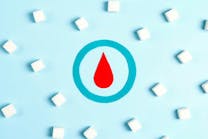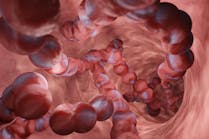The utility of
natriuretic peptides (NPs) — both brain natriuretic peptide (BNP) and
N-terminal prohormone brain natriuretic peptide (NT-proBNP) — as an aid
in diagnosing congestive heart failure (CHF) is well known. Both markers
have been shown in a number of studies to be useful blood tests to rule
in and rule out CHF. While numerous studies show these markers to be
clinically comparable, NT-proBNP has been deemed superior by many
investigators due to its increased half-life in blood.1,2 The
increased half-life of the NT-proBNP molecule compared to BNP is
advantageous in terms of improved prognostic value in both CHF and acute
coronary syndrome (ACS) as it “normalizes” individual biologic
variation, thereby enhancing the predictive value of the biomarker.
The detection of elevated BNP and NT-proBNP
levels in the blood (whole blood or plasma) correlates with severity of
CHF when assessed by the New York Heart Association (NYHA)
classification of CHF.3,4
Low levels of NT-proBNP can be used to rule out CHF with a high negative
predictive value.
NP tests are routinely performed in the central
laboratory. To improve the turnaround time (TAT) for reporting results
to clinicians, however, there is a need for rapid point-of-care tests
(POCTs) for use in emergency departments (EDs) and clinics to aid in
diagnosis, predict patient outcomes, and monitor the effects of acute
and long-term intervention.
Hospital discharges from CHF in the United States
rose from 400,000 in 1979 to 1,084,000 in 2005, an increase of 171%
(National Hospital Discharge Survey and National Heart, Lung, and Blood
Institute; American Heart Association [AHA] computation). More than
550,000 new cases are diagnosed each year, according to the AHA.5
Worldwide, more than 22 million people suffer from CHF, and two million
new cases are diagnosed each year, according to the World Health
Organization. The five-year mortality rate for CHF is as high as 50%,
and CHF represents the single largest expense for most developed
countries’ healthcare costs. Timely diagnoses are critical to reducing
the rising costs of healthcare.
Conventional diagnostic methods for heart failure
include the use of chest X-rays, pulmonary function, and stress-testing
electrocardiograms. Echocardiography (ultrasound) may also be used to
image the heart and aid in the determination of left ventricular
systolic dysfunction (LVSD), but is time consuming, expensive, and
requires a skilled technician and consultation with a radiologist.
Additionally, while these methods are valuable diagnostic tools, they
are usually not available at the point of treatment to augment standard
clinical symptoms of CHF, including dyspnea (shortness of breath),
pulmonary, and peripheral edema.
Until recently, there was no approved NT-proBNP
POCT in the United States for whole blood. Lab-based tests use plasma,
which requires an additional centrifugation step. Typically, a blood
sample sent from the ED to a central lab can take 45 minutes to more
than an hour to provide a result. TAT is particularly significant for
high-risk patients, leading to delays in medical intervention. A
whole-blood test in the ED can be conducted in about 15 minutes.
Clinical evidence of the NT-proBNP advantage
BNP and NT-proBNP are two separate pieces of
the parent proBNP molecule, a single-chain precursor peptide. In
CHF, the ventricle compensates by secreting increased NPs to
decrease fluid (diuresis) and sodium load (natriuesis) as well as
increasing vasodilation. Upon secretion from the cardiac myocyte,
proBNP splits into both inactive N terminal (NT-proBNP) and
biologically active C-terminal pieces (BNP). The concentration of
either NP in the blood is correlated with an increase in ventricular
size and ventricular pressure.6
Because BNP is biologically active, it is subject
to three forms of degradation and elimination, giving it a circulating
half-life of roughly 20 minutes. NT-proBNP, on the other hand, has just
one mechanism of clearance — renal filtration — resulting in a half-life
of approximately 120 minutes. This greater stability results in the NT-proBNP
molecule having better predictive value in CHF and ACS. One paired study
found NT-proBNP more accurately determined the odds of an adverse
outcome within 30 to 90 days of a second heart attack, the need for
urgent care (re-vascularization angioplasty or bypass), or death and was
also superior to BNP in predicting mortality and morbidity, and
re-hospitalization for heart failure.7
A comparison of the automated Roche NT-proBNP
assay and Biosite BNP assay found that NT-proBNP had good analytical
performance and better precision than Biosite BNP. Unlike BNP, NT-proBNP
is stable in EDTA plasma for three days at room temperature or longer at
4^0C.8 Although a patient’s gender, age, and renal function
must be taken into account to obtain an accurate NT-proBNP reading, a
clinically validated, cost-effective algorithm that accounts for these
factors exists.9
In a head-to-head comparison of NT-proBNP and BNP
in patients with/without LVSD, NT-proBNP was found to aid in identifying
LVSD. The authors concluded that although both assays are reliable and
have good analytical performance, the slightly wider detection range and
the more stable structure of NT-proBNP are an improvement in the
evaluation of patients with LVSD.10 Omland, et al, concluded
that the NT-proBNP is a “particularly strong predictor of heart failure
or death. This risk is independent of all other variables, including
renal function or troponin, and is proportional to the magnitude of NT-proBNP
release, with higher risk observed among those with a more marked
elevation of the marker.”11
Similarly, Januzzi, et al, found that “[i]n
addition to assisting in emergency diagnosis and triage, NT-proBNP
concentrations at presentation are strongly predictive of one-year
mortality in dyspneic patients.”12 The authors recommend
additional measurements at 24 to 72 hours and again at three- to
six-month intervals to improve long-term prognostic capability. In
patients with stable coronary-artery disease, these intervals may be
extended to six to 18 months. NT-proBNP is beneficial in the early
detection of CHF because it is more accurate than BNP in differentiating
patients with mild CHF from those without CHF, and it may enable the
prognosis in patients with mild cardiac dysfunction.13,14
There is a common misconception that renal
disease reduces the reliability of NT-proBNP measurements. But it has
been found that while both BNP and NT-proBNP are useful in predicting
CHF across a wide range of renal function levels, NT-proBNP was the
superior predictor of one-year mortality, particularly in patients with
chronic kidney disease.15
Cost benefits of the NT-proBNP testing
In addition to its diagnostic benefits, when
compared to the usual care for patients with symptoms of heart failure,
an NT-proBNP test can reduce medical costs by nearly $1,000 per patient.
These savings result from less time spent in the emergency department
and a significant reduction in the number of patients that are
re-admitted within 60 days.16 And the IMPROVE-CHF study
concluded that inclusion of NT-proBNP testing improves the management of
patients presenting to EDs with dyspnea through improved diagnosis, cost
savings, and improvement in selected outcomes.17 Similarly,
the “BATTLESCARRED” trial compared the usual care of CHF patients with
NT-proBNP-guided care and found there were fewer outpatient diagnostic
tests, including echocardiography, radionuclide ventriculography, and
computed tomography scan in the NT-proBNP group.18
Test availability
In the United States, BNP tests dominate the
market, with automated platforms for the lab from major manufacturers
including Siemens, Beckman, and Abbott Labs. BNP POCTs include Biosite
Triage and Abbott i-Stat. In Europe, however, NT-proBNP assays dominate
and their use within U.S. labs is growing, including such prominent
medical institutes as the Massachusetts General Hospital and the Mayo
Clinic. NT-proBNP tests for automated platforms are now
manufactured by Roche, Siemens Mitsubishi, and Ortho-Clinical
Diagnostics. NT-proBNP POCTs include the Roche Cardiac Reader and cobas
h 232 system, neither of which are currently available in the United
States.
An NT-proBNP POCT for whole blood has recently
been approved for use in the United States (Response Biomedical-RAMP NT-proBNP).
A second test — Nanogen’s Vyent NT-proBNP — is standardized to the
Roche Elecsys 2010 assay, CE Marked for sale in Europe, and expected to
receive 510(k) clearance in early 2009.19
Vyent NT-proCHF is a fully quantitative, 15-minute test performed on an
instrument the size of a small laptop computer.
The improved standard
The literature and widespread use of BNP and
NT-proBNP biomarkers demonstrate the value of these tests in the
diagnosis and prognosis of CHF. NT-proBNP has been shown to be
superior to BNP in several aspects when age-related cut-offs are
used. The South West London Cardiac Network Project for Optimising
the use of NT-proBNP Testing in Primary Care concluded that “NT-proBNP
is the test of choice in the diagnostic pathway for heart failure.
It facilitates equivalent measurements in both the hospital and
community without inconvenience to patients or carers and is,
therefore, adopted as the gold standard”20
and is highly sensitive for cost-effective exclusion of CHF in
symptomatic patients in a primary-care practice.21 With
its greater predictive value, cost savings, and high correlation to
central lab NT-proBNP testing, an NT-proBNP rapid POCT is an
invaluable diagnostic aid to emergency and clinical practitioners
alike.
Barry Bluestein, PhD, is senior director
and Alexander Belenky, PhD, principal scientist for Cardiac
Product Development for Nanogen Inc. in San Diego, CA.
References
- Ander D, et al. Society of Chest Pain
Centers Recommendations for the Evaluation and Management of the
Observation Stay Acute Heart Failure Patient Diagnosis. Crit
Pathways in Cardiol. 2008;7:91-95. - Januzzi JL, Richards AM, eds. An
International Consensus Statement Regarding Amino Terminal
Pro-B-Type Natriuretic Peptide Testing: The International NT-proBNP
Consensus Panel.Am J Cardiol. 2008;101(3A). - Mueller C, et al. The integration of BNP
and NT-proBNP into clinical medicine. Swiss Med Wkly.
2007;137:4-12. - Januzzi J, et al. NT-proBNP testing for
diagnosis and short-term prognosis in acute destabilized heart
failure: an international pooled analysis of 1256 patients: the
International Collaborative of NT-proBNP study. Eur Heart J.
2006;27:330-337. - American Heart Association. Heart Disease
and Stroke Statistics-2008 update. Dallas,Texas: American Heart
Association; 2008.
www.americanheart.org/presenter.jhtml?identifier=3000090.
Accessed November 5, 2008. - Bluestein B, et al. BNP and NT-proBNP
testing — what you don’t know about your laboratory’s test could
hurt you. Business Briefing: Emergency Medicine Review. June 2005 - Masson S, et al. Direct comparison of
B-Type natriuretic peptide (BNP) and amino-terminal proBNP in a
large population of patients with chronic and symptomatic heart
failure: the Valsartan Heart Failure (Val-HeFT) data. Clin Chem.
2006;52:1528-1538. - Yeo, K, et al. Multicenter evaluation of
the Roche NT-proBNP assay and comparison to the Biosite Triage BNP
assay. Clin Chim Acta. 2003;338:107-115. - Januzzi J, et al. Amino-terminal
pro-B-type natriuretic peptide testing for the diagnosis or
exclusion of heart failure in patients with acute symptoms. Am J
Cardiol. 2008;101[Suppl]:29A-38A. - Vanderheyden M, et al. Head to head
comparison of N-terminal pro-B-type natriuretic peptide and B-type
natriuretic peptide in patients with/without left ventricular
systolic dysfunction. Clin Biochem. 2006;39:640-645. - Omland T, deLemos J. Amino-terminal
pro-B-type natriuretic peptides in stable and unstable ischemic
heart disease. Am J Cardiol. 2008;101[Suppl]:61A-66A. - Januzzi JL, et al. Utility of
amino-terminal pro-brain natriuretic peptide testing for prediction
of 1-year mortality in patients with dyspnea treated in the
emergency department. Arch Intern Med. 2006;166:315-320. - Emdin M, et al. Comparison of brain
natriuretic peptide (BNP) and amino-terminal proBNP for early
diagnosis of heart failure. Clin Chem. 2007;53:1289-1297. - Omland T, et al. Prognostic value of
B-type natriuretic peptides in patients with stable coronary artery
disease, the PEACE trial. J Am Coll Cardiol. 2007;50:205-214. - DeFilippi C, et al. Impact of renal
disease on natriuretic peptide testing for diagnosing decompensated
heart failure and predicting mortality. Clin Chem.
2007;53:1511-1519. - Januzzi J, et al. NT-proBNP levels,
echocardiographic findings, and outcomes in breathless patients:
results from the ProBNP Investigation of Dyspnoea in the Emergency
Department (PRIDE) echocardiographic substudy. Eur Heart J.
2006;27:839-845. - Moe G, et al. N-terminal pro-B-type
natriuretic peptide testing improves the management of patients with
suspected acute heart failure: primary results of the Canadian
prospective randomized multicenter IMPROVE-CHF study. Circulation.
2007:115:3103-3110. - Lainchbury J, et al. NTproBNP-guided drug
treatment for chronic heart failure: design and methods in the
“BATTLESCARRED” trial. Eur J Heart. 2006;8:532-538. - Vyent ™ NT-proBNP Package Insert, Part
No. 141090, RevA , Nanogen, Inc., San Diego, CA. Data on file. - Optimising the use of NTproBNP Testing in
Primary Care.
www.heart.nhs.uk/BNP/south_west_london/optimising_NTproBNP_in_PC.ppt.
Accessed November 13, 2008 - Hildebrandt P, Collinson P. Amino-terminal
pro-B-type natriuretic peptide testing to assist the diagnostic
evaluation of heart failure in symptomatic primary care patients. Am
J Cardio. 2008;101[suppl]:25A-28A.




